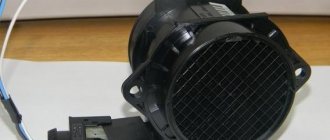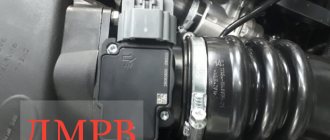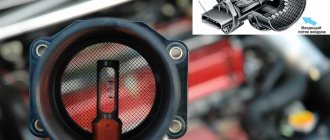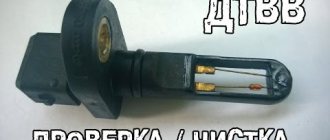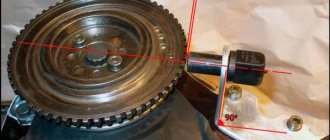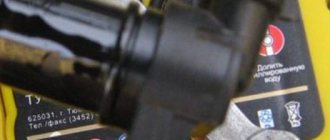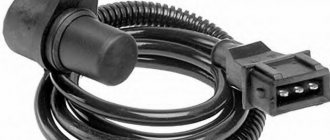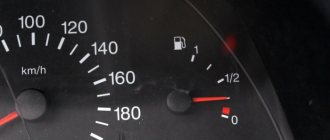What is the VAZ 2114 mass air flow sensor and what functions does it perform? The primary task of the regulator is to create arrogance from air and fuel vapors.
The regulator can measure two interconnected parameters, namely:
- reaction time;
- volume of air used.
In accordance with the information received, the correction device determines the required volume of components to create the mixture. If incorrect data is provided, the mixture will not be able to correspond to the operating mode of the power unit; accordingly, its power may decrease and fuel consumption may increase.
DMRV 2114 device diagram
What air flow should be on a VAZ 2114?
A 1.5 liter VAZ 2114 engine with a working mass air flow sensor at 850-950 rpm consumes from 10±0.5 kg of air per hour of operation, and at 2000 rpm - from 19 kg to 21 kg. If the amount of air consumed at the same speed decreases, the dynamics of the car also decreases, but fuel is saved. Conversely, increased air consumption leads to increased dynamics and higher fuel consumption. In this case, it may be difficult to start the engine in cold weather. If the sensor readings deviate from the real ones by 2-4 kg, the engine will begin to become very capricious and “dull”. Disabling the sensor will force the motor to continue operating in emergency mode.
Causes of malfunction
Common to most domestic cars, the reason why the VAZ 2114 air flow sensor breaks is hidden in the crankcase ventilation system. It has two circuits that ensure operation with the throttle valve open or closed. If the throttle is buried, crankcase gases are discharged along the line (d=1.5 mm) into the space available behind it. A certain percentage of these gases accumulates in the idle line, where it comes into contact with the film-coated MAF resistor. It is also sensitive to fluctuations in the gas mixture in the intake system. The resin settles on the surface of the resistor, and the sensor begins to “lie.” Because of this, the idle air control sticks, and it begins to jam when starting the engine.
CHARACTERISTIC SIGNS OF MALFUNCTION
As already mentioned, a working mass air flow sensor on a VAZ 2114 is a necessary condition for the normal operation of the engine of the fourteenth, and if any problems arise with the device, they will certainly affect the functioning of the engine, which you will immediately feel.
The air consumption at idle speed of the VAZ 2114 varies between 8-10 kg/hour; when the engine operates at 3000 rpm, it increases to 29-31 kg/hour. In this case, the optimal ratio of gasoline and air in the fuel mixture is 1 to 15.
If the MAF readings differ from the actual consumption, the amount of gasoline is calculated incorrectly, which contributes to either excessive fuel consumption or problems with the engine.
Signs of a malfunctioning mass air flow sensor:
- First of all, engine malfunctions will begin at idle speed - the speed will begin to float or increase on its own;
- Then the dynamics of acceleration will worsen - the car will stall even when accelerating from a hill;
- Due to the incorrect ratio of gasoline and air, fuel consumption will increase significantly (up to a twofold increase);
- Also, the fourteenth may stall when trying to change gears.
Don’t be fooled by the absence of a lit “Check Engine” indicator on the dashboard, because if the mass air flow sensor does not show any signs of life at all, the light may not light up.
If your fourteenth is equipped with an on-board computer, it will display the error “Insufficient air flow sensor signal level”
It can be caused by various factors:
- weak fixation of the contact block;
- oxidation of the contacts themselves or broken wiring;
- damage to the sensitive element;
- broken internal wires.
No matter what signs of a malfunction of the mass air flow sensor appear, to make a final conclusion about the operability of the device, it is necessary to check it.
Purpose and principle of operation
Many car owners are concerned about how much it costs to purchase such a sensor. It turns out that the DMRV 2114 has a considerable cost, it varies between 2-3 thousand. In this case, you can use both imported products and domestically produced parts. You shouldn’t be surprised that there are corresponding reviews about domestic models.
But you shouldn’t always trust reviews; it’s better to try the products in practice. Although you can find a lot of negative reviews about domestic sensors, they are more affordable.
This sensor allows the engine to operate in different operating modes, involving different loads. If we consider the operation of the device, it consists in creating a working mixture of air and gasoline. More precisely, the mixture includes gasoline vapors. The direct task of the product is to measure two indicators that are interconnected:
- Reaction time.
- The amount of air that is consumed for the reaction.
If the measurements are accurate, the device can determine what mixture the engine requires. This allows the system to obtain information about the required proportions. There are also situations when the sensor does not work correctly, producing incorrect values.
In this case, the mixture created in the system will not correspond to the current operating mode. As a result, power may decrease and consumption will likely increase. Among the possible consequences may be a deterioration in the dynamics of the car and a disruption in the response of the car.
Attention! The response of parts from different manufacturers may vary significantly. It is important to take this point into account when checking the operation of the sensor.
How to check the MAF sensor on a VAZ
The most reliable way is to use a diagnostic scanner (at least at the ELM-327 level). We connect to the OBD port and look at the flow meter performance indicators on the computer.
If you don’t have a scanner, you can take the basic parameters with a multimeter. To diagnose and repair the VAZ 2114 mass air flow sensor with your own hands, you need to know the pinout of the contacts.
For example, consider a contact block for a VAZ 2114: a modern 8 or 16 valve engine, BOSCH mass air flow sensor (or its equivalent) version 116.
- We don't need contact No. 1; this is an air temperature sensor.
- Contact No. 2 - 12 volt power supply. If the on-board voltage regulator malfunctions, the air flow sensor may malfunction.
- Contact No. 3 - ground.
- Contact No. 4 - power supply for the mass air flow sensor electronics, an important parameter, the voltage must be stable.
- Contact No. 5 is the same “floating” voltage with which the ECU calculates the volume of air passing through the intake manifold.
The supply voltage is checked with the block disconnected. We turn the ignition key, but do not start the engine. With respect to ground, we measure the voltage at contact No. 2 (12 volts) and contact No. 4 (5 volts). This indicates the serviceability of the ECU and the integrity of the wires and contacts.
Checking the signal voltage on pin No. 5 is carried out with the connector connected, with the ignition on (do not start the engine!).
- voltage is within 0.99-1.02 volts - the sensor is working;
- voltage within 1.03-1.05 volts - replacement will be required soon;
- more than 1.05 volts - the mass air flow sensor does not operate normally.
Characteristic
On VAZ cars, the mass air flow sensor is mounted between the air filter element and the throttle hose. Today, products from the manufacturer Bosch are very popular among compatriots. Regardless of whether it is a universal Bosch sensor or, for example, spark plugs, quality from a German manufacturer can always give a head start to domestic products. Let's look at the main characteristics of regulators models 116 and 037.
DMRV 116 is designed to control and convert the air flow that enters the motor into voltage. The data transmitted by the regulator makes it possible to determine the operating mode of the power unit and calculate the cyclic filling of the cylinders with air flow. This filling is carried out in steady-state operating modes of the motor, which last no more than 0.1 seconds.
Let's look at the technical features that Bosch 0 280 218 116 has:
- the regulator operates on the principle of measuring air flow;
- the device provides accurate data, which ensures optimal fuel consumption;
- operating range varies from 8 to 550 kg/h;
- the output pulse level when measuring the range from 0 to 100% will be about 0.05-5 volts;
- As for power supply, the controller is powered from the vehicle’s electrical network, that is, 12 volts is enough for it;
- current consumption is about 0.5 ampere;
- the regulator can function normally in the operating range from 45 degrees below zero to 120 degrees;
- The service life of the Bosch 116 mass air flow sensor is about 3 thousand hours.
Bosch 116 device
As for the mass air flow sensor 037 from Bosch, the technical features will be similar. The controller consists of two main elements - working and control, as well as a heating resistor device. The air that enters the engine cools one of the controllers, while the electronic module converts the temperature differences between the controllers. In the event that sensor 280 218 037 fails, its options will be performed by TPS.
As mentioned above, the technical features of the models are the same:
- the operating range for normal operation varies in the region of 8-550 kg/h;
- when operating correctly, the controller will provide accurate data, making it possible to achieve optimal gas mileage (of course, if the engine is running in normal mode);
- since the element is used in a car, it is logical that it should be powered by 12 volts;
- the controller consumes about 0.5 ampere of current;
- the part can operate normally both at 45 degrees below zero and at 120 degrees of heat, this is its operating range;
- service life is at least 3 thousand hours;
- unlike model 116, the new mass air flow sensor 037 during calculations can produce an error of 2.5 percent (both downward and upward).
Regulator model 0280218037
Device malfunctions and diagnostics
When a breakdown occurs, symptoms appear that are difficult to miss during constant use of the VAZ 2114:
• Motor power becomes lower; • The car does not start well even when it is hot; • Increased fuel consumption; • Acceleration is slower than usual.
These are the main diagnoses. They may also appear during other failures affecting the power plant. To be sure that the mass air flow sensor is not working properly, you need to check the device. There are a lot of ways to check a device, but two main ones are worth highlighting: visual inspection and testing with a multimeter.
Visual inspection
It is necessary to remove the clamp from the corrugation, which is attached to the air intake. You can unscrew it with a Phillips screwdriver. It is necessary to carefully check the surfaces of the corrugation and flow meter. They should have no traces of oil or condensation, and the sensor should be clean. But if the owner of a VAZ 2114 rarely changes the air filter, then you shouldn’t be surprised at the breakdown of the mass air flow sensor - the ingress of dirt will be fatal to the electronics.
Oil on the sensor is a warning that the oil level in the crankcase has increased, or a clogged oil sump may also be the cause. To test this theory, you need to remove the two fasteners with the tenth key and remove the flow meter from the filter housing. A rubber sealing ring must be installed on the inlet edge of the air filter. If it is not there, it means it has gotten into the air filter. In this situation, a small layer of dust appears on the inlet grid of the mass flow sensor. Such a defect also often damages the device, so it is necessary to change the air filter in the VAZ 2114 and also check it regularly. In the case of dust deposits, the VAZ 2114 sensor can be brought back to life - you need to carefully clean it, put on a seal and place it inside the case.
Checking with a multimeter
This method is suitable for modern flow meters. To check it, you need to turn on the multimeter and set it to measure DC current. The limit on the device should be set to 2 Volts. The MAF has the following pinout:
• Pink/black leads to the main relay; • The yellow wire goes to the signal input (it is located on the side of the windshield); • Green wire – ground; • Gray-white wire – voltage output.
While the colors may vary depending on the manufacturer, the layout always remains the same. Now you need to activate the ignition, but you do not need to start the engine. You should take a multimeter and connect its red probe to the yellow signal wire, and the black one to the green one. This combination allows you to measure the voltage between two elements. The ends of the tester probes allow you to take measurements without damaging the insulation of the structure - you need to go along the indicated wires.
Tip: It is not recommended to use attachments (for example, needles), as they cause errors. There should be a spread in the diagnosis of a mass air flow sensor, since every number is important.
The output voltage of the new device will be from 0.966 to 1.01 V. But over time, the indicator changes, usually the voltage increases upward. The more the indicator goes up, the more wear on the flow meter. By measuring you can determine the condition of the device:
• From 1.01 to 1.02 – the flow meter is working properly; • From 1.02 to 1.03 – tasks are being completed, but there is already wear and tear; • From 1.03 to 1.05 – the mass air flow sensor will soon be faulty; • From 1.5 and more – the sensor does not work and requires replacement.
Cleaning instructions
As practice shows, cleaning the mass air flow sensor is one of the most effective methods of restoring the functionality of the controller. Therefore, if the sensor breaks down, it is not necessary to change it, especially since such a pleasure today is not cheap. This procedure is necessary because over time it becomes dirty and shows other parameters.
So, how to clean the mass air flow sensor at home with your own hands:
- You will need a Phillips head screwdriver; use it to loosen the clamp securing the line from the air intake.
- Next, dismantle the corrugation and visually assess the condition of the system. You may see condensation or traces of engine fluid under the corrugation.
- Carefully inspect the inside of the controller. If everything is normal with the system, then there will be no traces of leaks or contamination. As practice shows, the sensitive element often breaks precisely due to an excess of contamination. In order not to avoid problems of this kind in the future, it is necessary to periodically replace the air filter. This procedure is carried out in accordance with technical regulations. Engine fluid may enter the controller as a result of an increased level of consumables in the crankcase. Accordingly, this occurs as a result of a clogged oil separator in the ventilation system.
- The regulator itself is fixed with two bolts on the line. The removal procedure is carried out using an open-end wrench. At this stage, if you are sure that the device has failed, you can replace it.
- You can see the entrance on which there will be a sealing rubber band designed to protect the device from the suction of dirty air flow. If you do not have a seal, it may have caught on the filter element. Accordingly, this will lead to the regulator input grid being contaminated.
- Clean the mesh using available materials. To do this, you can use a regular toothpick or toothbrush. After cleaning, the seal can be put back and the regulator can be put back in place.
CHECKING THE FUNCTIONAL STATE OF THE DMRV
To determine that this particular unit is faulty and the mass air flow sensor needs to be washed and repaired, you need to check the mass air flow sensor with a multimeter.
A multimeter, also known as a tester, is an electronic device that can be purchased at any auto store at a price of 400-600 rubles for the simplest models (their functionality will be quite enough for us). It is not inexpensive and will be useful in the garage many times - you can use it to check any sensors and electronic systems of the car.
The serviceability of the mass flow sensor is checked as follows:
- We switch the tester to voltmeter mode and set the upper limit of sensitivity to 2 Volts;
- We connect the multimeter probes to the yellow and green wires (they are located in the sensor connection socket);
- We activate the ignition (there is no need to start the engine) and look at the tester reading.
Examination
There are several ways to check the functionality of the flow sensor. But first you need to determine where the desired object is located.
And our hero is in the engine compartment. Find the air filter pipe there. It is on this that the mass air flow sensor is located, which monitors the air flow passing through the filter. Replacing it is simple - just dismantle the device by removing it from its fasteners and putting a new one in place.
Now regarding the verification.
- Disconnect the sensor by disconnecting the wiring harness from the connector. Press the latch at the bottom and you'll be good to go. Now start the engine and raise the speed to at least 1500 rpm. By turning off the sensor, the car will perceive this as an emergency condition, so the mixture will be prepared depending on the current throttle position. Drive a short distance. If the car accelerates faster than usual, the mass air flow sensor has definitely failed.
- Replace the firmware. The original firmware of the electronic control unit is often changed. Therefore, we cannot find out which sensor operation algorithm was prescribed in the case of the first verification method. The throttle valve has a stop; a plate approximately 1 millimeter thick should be placed under it. This will increase the speed. Now the chip with the sensor is disabled. If the mass air flow sensor does not work, the engine will stall. If this does not happen, then the firmware is not original, the steps of the idle speed control are written incorrectly.
Checking with a multimeter
To do this, you will have to use a multimeter. And how can I check the functionality of the sensor using this method? Select the DC voltage measurement mode on the device and set the maximum value to 2V.
Check with a multimeter
Separately, you should familiarize yourself with the connection diagram in the case of the VAZ 2114.
Subsequence
Wire color
Meaning
Power output
Main relay output
In some cases, the color may differ, but the sequence always remains the same. This will prevent you from getting confused.
Turn on the ignition with the engine off. The positive probe of the multimeter is connected to the yellow output of the sensor, and the black, that is, positive, goes to the green.
The probes of the measuring device should be inserted through the rubber seals of the connectors without damaging the insulation. The probes should be moistened with the almighty WD 40. Now measure the voltage readings. Compare the result obtained with the data from the table.
Voltage indicator
Air flow sensor condition
The air flow sensor is in good working order, almost new condition, can serve for a long time
The sensor is in good condition, although old. There are no complaints about performance
The air flow sensor is in poor condition, has almost expired and will require immediate replacement
The condition is critical, the resource is exhausted. It is recommended to replace it as soon as possible to avoid troubles.
If you install a new sensor, it will initially show readings in the region of 0.996-1.01 V, but over time the voltage will begin to increase. This indicates wear.
Cleaning
Cleaning is one of the most effective ways to bring the mass air flow sensor back to life and ensure its operation for more than one season of operation of your VAZ 2114.
Let's figure out how to clean this measuring device.
- Using a Phillips screwdriver, loosen the clamp that holds the pipe from the air intake.
- Remove the corrugation and check if there are traces of oil or condensation inside.
- Examine the condition of the internal surface of the mass air flow sensor itself.
- If everything is fine, there should be no traces of contamination.
- The sensitive component of the sensor often fails due to contamination.
Repairs and expenses
If the mass air flow sensor in your car has failed, we recommend having it repaired at a car repair shop. Fortunately, the cost of labor to replace the sensor is low, since the air flow sensor is easily accessible in most cars. In most cases, replacing an air mass meter will take approximately 15 minutes to 1 hour, depending on the make and model of the car.
Unfortunately, in many modern cars, a special tool is required to replace the mass air flow sensor. Also, in many modern cars, after replacing the air flow sensor, you may have to “register” the flow meter in the engine control unit, thereby informing the electronics about the new sensor. Unfortunately, therefore, not all car owners who are familiar with auto repair can independently change the mass air flow sensor in their car.
Is it worth buying a non-original mass air flow sensor? Unfortunately, the cost of the mass air flow sensor is not small. Therefore, many drivers are often interested in the question: is it possible to purchase an analogue instead of the original flow meter?
This question cannot be answered unequivocally. It all depends on the make and model of your car and of course the manufacturer of the sensors. For example, there are cars on the market for which you will not find non-original sensors.
We do not recommend that you buy non-original sensors, because in this case you risk simply throwing away your money, since, according to statistics, non-original sensors do not last long.
If you still decide to purchase a non-original mass flow sensor, then choose only reliable suppliers from well-known manufacturers.
Unfortunately, the cost of mass air flow sensors is quite high (especially in modern new cars). So we advise you not to save money, because if you spend a lot of money on a non-original one, you may encounter a short service life of the sensor, and eventually, sooner or later you will purchase an original flow meter.
Agree, this is unreasonable.
Remember that sometimes savings can backfire. Especially when it comes to electronic automotive components.
We would also like to note that in some cars the mass air flow sensor is built into the engine control unit. In this case, the cost of repairing the sensor can cost a very large amount.
In this case, your only way to save money is to look for a company that repairs such units. Typically, such companies repair such units by changing the mass air flow sensor built into the engine control unit.
Yes, repairs in this case will not be cheap, but nevertheless they are not comparable to the cost of a new engine control unit.
How to check the air sensor yourself
So, if the driver exhibits the signs discussed above, then the sensor needs to be checked. By the way, it is important to understand that the symptoms of a malfunction of the VAZ 2114 DMVR can be very similar to the symptoms of malfunctions of other components of the car. For this reason, diagnostics are necessary before starting repair work.
- contact “5” - supplying an incoming signal from the electronic control unit (yellow wire);
- pin “4” - power supply to the device (gray or white wire);
- contact “3” - grounding (green wire);
- contact “2” - transfer of information from the sensor to the main relay (pink-black wire).
To check the VAZ 2114 mass air flow sensor using a multimeter, do the following:
- Set the multimeter to DC measurement mode up to 20 V.
- connect the red wire from the multimeter to pin “5”, and the black wire to pin “3”;
- Turn the ignition on without starting the car and look at the multimeter readings.
Decoding multimeter readings:
- tester reading from 0.006 V to 1.01 V - the voltage of the new sensors, after several operating weeks the voltage increases by several hundredths of units;
- tester reading from 1.01 V to 1.02 V – normal operating voltage of the sensor under normal operating conditions;
Then, based on the indications, appropriate repair work is carried out. In some cases, you can limit yourself to cleaning, checking contacts, etc. Others will require a complete replacement with a new device.
How to properly clean the mass air flow sensor?
The cost of a new sensor sometimes reaches 4,000 rubles. When identifying its breakdowns, you cannot do without these expenses. But if the device gets dirty, you can clean it yourself. To do this, use special chemicals that are sold in car dealerships. For example, chemistry from Liqui Moly. A mixture of 30% distilled water and 70% isopropyl alcohol works well. To wash the part, it is not advisable to use carburetor cleaners, WD-40, dishwashing liquid or window cleaner. Cleaning is done like this:
- Remove the device and its housing from the car;
- Separate the sensor from the housing. You can use pliers to unscrew the fasteners;
- Wash the resistors and channels of the part with chemicals. When using the product, you need to warm it up with a hair dryer to about 70 degrees.
- Dry the device sensor;
- Wash the body with soapy water, and then with water and dry it;
- Assemble the element and install it in place.
In order to save money, some drivers try to restore the functionality of a broken mass air flow sensor by installing additional resistors, changing the ECU firmware, or blocking part of the air supply channel with aluminum. These methods may be dangerous or ineffective. Therefore, in the event of a breakdown, the part must be replaced.
